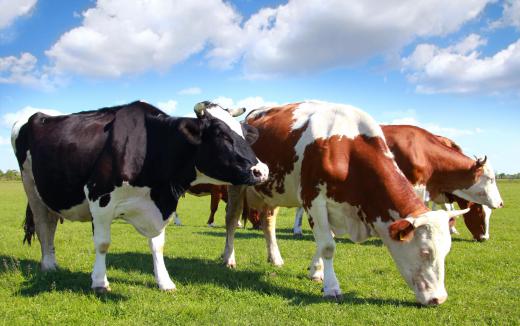What is Biogas Production?
Biogas production is the creation of biofuel using the anaerobic decomposition of organic materials. Anaerobic decomposition of organic materials occurs when biodegradable matter from a living or once-living organism decays with the help of microorganisms in an oxygen-free environment. Biogas is often celebrated by environmentalists for its relatively low carbon output. It can act as a substitute for fossil fuels as an energy source for heating and vehicle transportation. Biogas production typically occurs in a biogas plant on a large or small scale, depending on the materials available.
A biogas plant has two principle components, a digester and a gas holder. The digester is an airtight container in which the organic waste is dumped and decomposed, and the gas holder is a tank that harnesses the gases emitted by the slurry. Bacteria within the digester tank breaks down the waste and, as it decomposes, gases such as carbon monoxide, methane, hydrogen, and nitrogen, are released.

Through a pressurized system, the gas holder conducts the flow of these gases upward into a hole in the drum of the holder. The hole is specially designed to allow gases to pass freely into the holder while preventing any gases from escaping back into the digester. When the gas is ready to be used, the gases are put in contact with oxygen in a controlled environment to create a combustion reaction. This combustion produces an energy source for such processes as heating and vehicle propulsion.
Biogas production can occur in different types of plants, depending on the amount of gas needed, the amount of waste at hand, and whether the digester is designed for batch feeding or continuous feeding. Batch feeding systems decompose mostly solid wastes that are added to the tank in installments, while continuous feeding models feed mostly liquids to the digester. Biogas production can be achieved in above or below ground plants, though both models have advantages and disadvantages. An above ground biogas plant is easier to maintain and able to benefit from solar heating, but takes more care in construction. A below ground biogas plant is cheaper to construct and easier to feed, but more difficult to maintain.
Biogas production is often preferred to fossil fuel energy sources, such as oil or coal, for environmental and economic reasons. The rising concentration of carbon, a greenhouse gas, in the atmosphere has become a central issue in the problem of global warming. Though both biogas and fossil fuels emit carbon, fossil fuels release carbon that has been buried for many years in ancient biomass and effectually removed from the carbon cycle. Carbon released during biogas production and use has been stored in the form of organic matter only recently and is still part of the cycle. Therefore, it does not cause as much of an upset in the carbon concentration in the atmosphere.
Proponents of biogas production also prefer biogas to fossil fuels because it is a low cost, renewable source of energy, and it uses otherwise wasted materials. Biogas production may also occur in small-scale sites, making it a viable option for regions in developing nations. Critics of biogas argue that food crops grown for the purposes of biogas production will create a global food shortage. Biofuels may also cause deforestation, water pollution, soil erosion, and a negative impact on oil producing nations.
AS FEATURED ON:
AS FEATURED ON:











Discussion Comments
I would like to know why a below ground biogas is cheaper to construct? This doesn't make sense to me as you have to take into account that you have to dig a hole before construction, that already cost money. Thanks in advance
Excrement from farm animals and waste from the food industry contains organic materials.
The gas produced from the bio-matter degradation can be converted to electricity by means of a gas engine or turbine.
what are the raw materials for biogas? how is biogas produced? how is electricity produced from biogas?
Post your comments